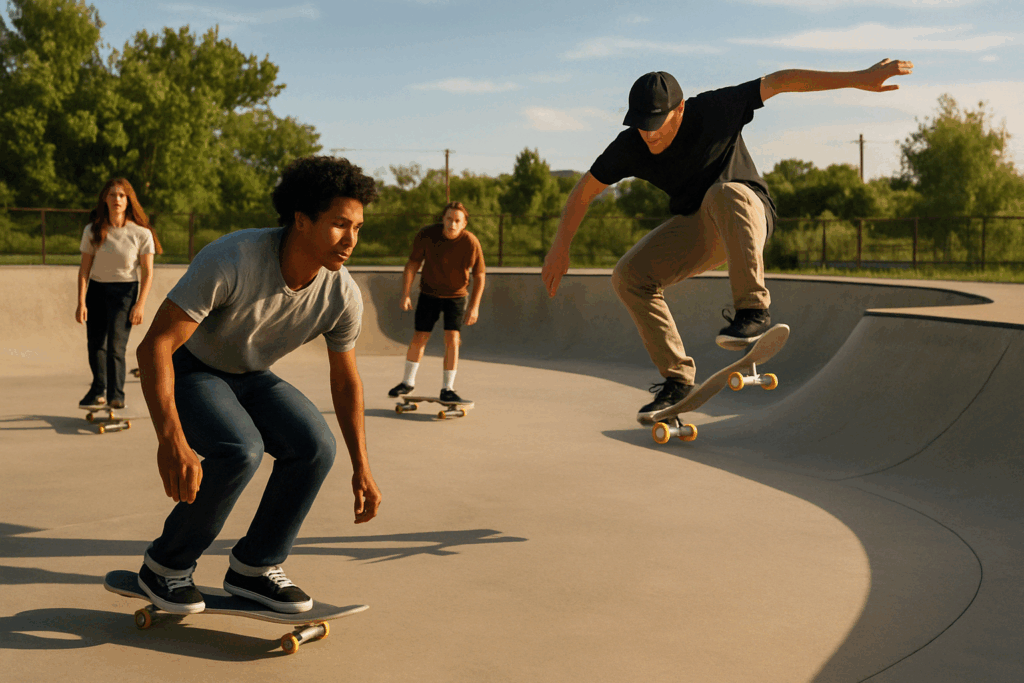
Skateboarding isn’t just a sport—it’s a culture, a lifestyle, and a global movement that’s shaped fashion, music, and street art. But where did it all begin? How did a humble wooden plank with roller skate wheels evolve into a billion-dollar industry and Olympic sport?
This blog dives deep into the gritty, rebellious, and creative journey of skateboarding history—from the surf-inspired sidewalks of California to the concrete jungles of modern cities worldwide.
🏄♂️ The Birth of Sidewalk Surfing (1940s–1950s)
Skateboarding began as a land-based alternative for surfers in Southern California. When waves were flat, surfers created makeshift boards using wooden planks and roller skate wheels—giving rise to “sidewalk surfing.”
Early boards were clunky, and metal or clay wheels made them hard to control, but this marked the beginning of what would become a worldwide phenomenon.
🌊 Surf Style on Concrete (1960s)
By the early 1960s, skateboarding exploded in popularity. Makaha and Hobie were among the first commercial skateboard brands. Magazines like The Quarterly Skateboarder launched, and the first skate competition was held in 1963.
The vibe was still heavily influenced by surfing, and tricks focused on flowing style, balance, and carving. However, this first boom faded quickly by the mid-60s due to safety concerns and lack of infrastructure.
🛹 The Urethane Revolution (1970s)
The 1970s changed everything.
In 1972, Frank Nasworthy introduced urethane wheels, which gave riders more grip, smoother rides, and the ability to carve like never before. This tech revolution reignited skateboarding’s popularity.
At the same time, California was hit with a drought, causing empty backyard swimming pools—which skaters like Tony Alva, Stacy Peralta, and the Z-Boys turned into vertical playgrounds.
The pool sessions birthed vert skating and laid the foundation for modern skateboarding style—fast, aggressive, and radical.
🧱 The Street Skating Boom (1980s)
In the 1980s, skateboarding began moving away from ramps and pools and into the streets.
Pioneers like Rodney Mullen revolutionized the sport by inventing flatground tricks like the kickflip, heelflip, and ollie—the building blocks of all modern street tricks.
Skateboarding also clashed with authority: “No Skateboarding” signs went up in cities, and skaters began embracing a rebellious, anti-establishment image. Video magazines and VHS tapes like Powell Peralta’s “The Search for Animal Chin” spread the scene globally.
🎸 Culture Explosion (1990s)
The 1990s saw skateboarding’s raw edge explode into pop culture.
- Skateboard magazines like Thrasher and Transworld Skateboarding dominated.
- Skateboarding collided with punk, hip hop, and grunge, forming a unique subculture.
- Street skating became the dominant form, with legendary pros like Eric Koston, Jamie Thomas, and Chad Muska.
- Video games like Tony Hawk’s Pro Skater brought skateboarding to millions of new fans.
The DIY ethic fueled a boom in skate videos, local brands, and homemade spots like Love Park and EMB.
🏆 Mainstream Recognition and Innovation (2000s–2010s)
Skateboarding slowly crept into the mainstream. Corporate brands entered the scene. Pro skaters earned sponsorships. Parks were built in cities. Documentaries like Dogtown and Z-Boys and Lords of Dogtown told its story to the world.
But the heart of skating stayed underground, DIY, and creative. The era saw technical street skating reach new levels, led by legends like Paul Rodriguez, Daewon Song, and Nyjah Huston.
Skateboarding also went global—flourishing in Japan, Brazil, South Africa, and Europe.
🥇 Skateboarding in the Olympics (2020s)
In 2021, skateboarding made its Olympic debut in Tokyo with two categories: street and park. It was a moment of validation for a culture that had once been banned, fined, and misunderstood.
But skateboarding didn’t lose its edge—it simply evolved. While some debate the mainstream spotlight, many see the Olympics as a platform to inspire a new generation of skaters.
🌍 Skateboarding Today: Global, Diverse, and Limitless
Skateboarding in 2024 is more diverse and inclusive than ever. Women, LGBTQ+ skaters, and skaters from marginalized communities are carving out space and reshaping what it means to be a skater.
From community-built skateparks to artful video parts, skateboarding continues to evolve while holding true to its DIY, rule-breaking spirit.
✨ Final Thoughts
Skateboarding’s history is a story of rebellion, invention, and transformation. It’s not just a sport—it’s a creative outlet, a form of resistance, and a way of life. Whether you’re dropping in at your first bowl or filming lines in the city, remember: you’re riding on decades of history… and it’s still being written.
#skateboardinghistory #concretewaves #skateculture #zboys #streetskating #skateboardlife #thrashermag #skateboardrevolution #skateeverydamnday #olympicskateboarding #tonyhawk #rodneymullen #powelperalta #skatevideos #vertskating #skatecommunity #kickfliplife #90sskateboarding #skateboardlegends #diyskatespots #urbanskating #skateboardingroots #camdenskate #skateeverywhere #globeskating #skateart #skateboardfashion #beyondtheboard #skateboardingworld #skateislife